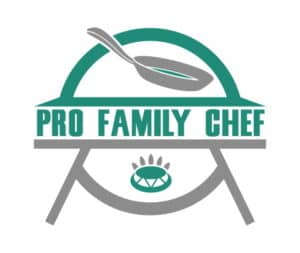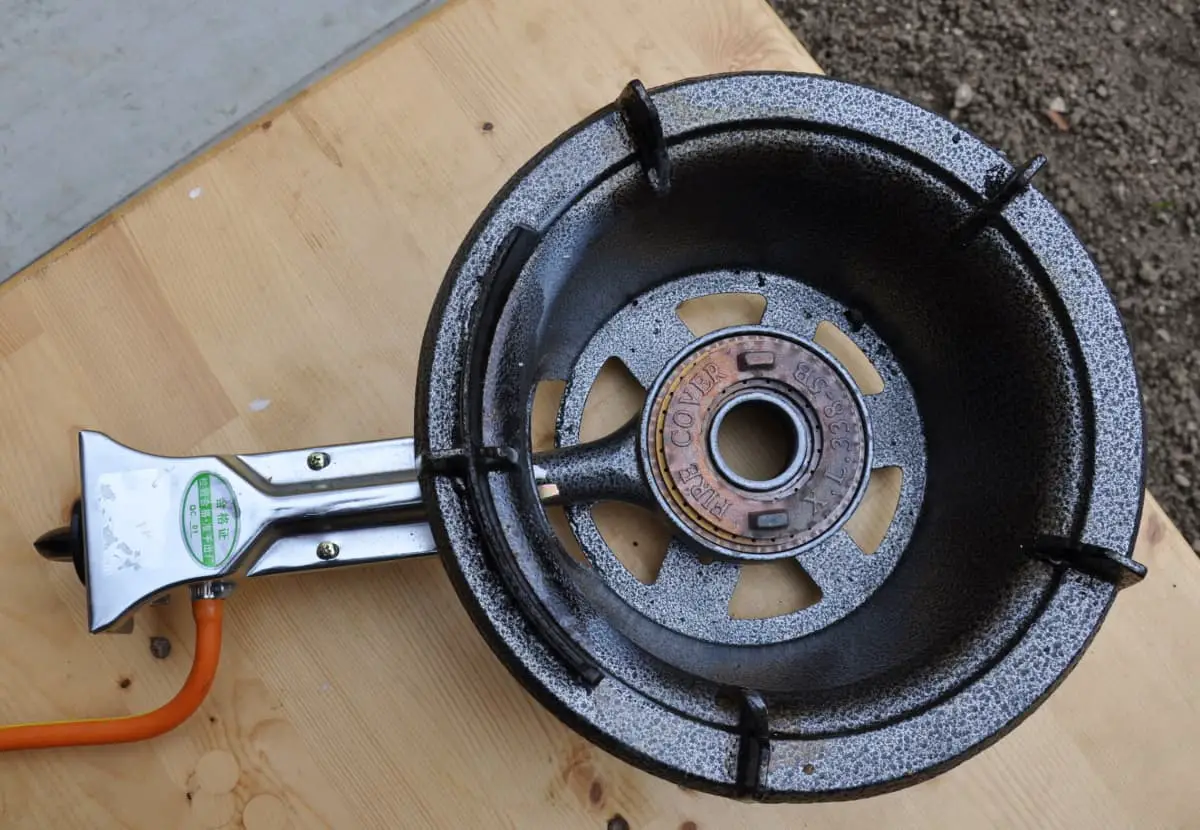If you’ve recently purchased a wok burner, or if you are thinking of purchasing a wok burner, it is important to understand how it works and how heat is produced.
In this post, I am describing the wok burner on the pictures which is also the best wok burner and the one I use!
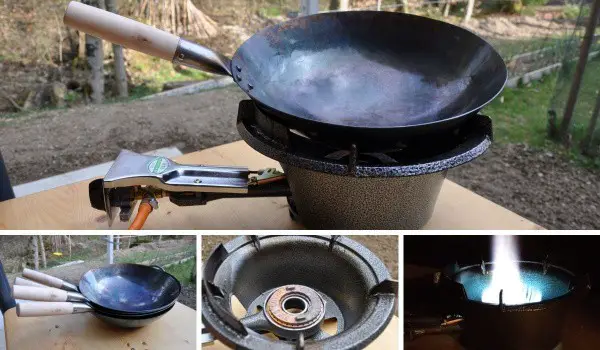
How does the wok burner work
A wok burner has several key components working together to create that beautiful flame that heats up the wok when cooking your food.
Firstly, it’s important to understand what the different components of a wok burner are. The wok burner equipment consists of a hose, a regulator, a gas tank, and the burner itself.
Let’s start with the pressure regulator attached to the propane take. By opening the main valve on the gas tank, the 0 to 60 psi regulator delivers propane under pressure through a rubber hose. The regulator features a knob at the top that acts as an adjuster. This adjustment increases or decreases the pressure that will increase or decrease the size of the flame.
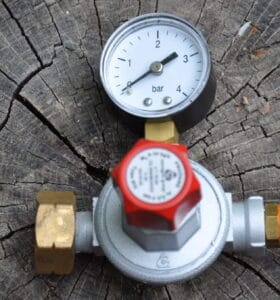
The hose connects to the burner and the pressure regulator via brass fittings. The regulator hooks up to the gas tank via a brass fitting known as a pigtail. The two fixtures are connected by hand. A small wrench can be used to secure the fixtures so that they sit snuggly but not too tight.
The end of the hose is connected to the burner via a brass fitting. It can be tightened using your fingers and further tightened using a crescent wrench as well. Keep in mind that the brass fixtures are actually a softer kind of metal and do not require extreme tightening. It should simply sit snug around the fixture.
The second adjustment feature sits at the bottom of the burner. It is a washer that sits on the valve stem. This adjustment controls the air/ fuel mixture that is delivered through the burner.
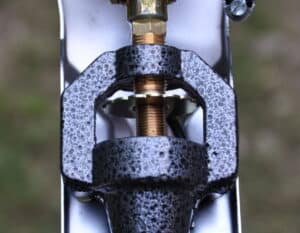
Before the burner is switched on, the main valves of the burner need to be closed. The main valve on the gas tank is opened slowly. This will put the line under pressure.
The pilot valve, on the burner, is opened up. Opening the pilot valve on the burner allows the gas to flow. Keep in mind that there are either manual or automatic ignitions on the wok burner. An automatic ignition is switched on simply by turning the knob. A manual ignition is sparked by a flame.
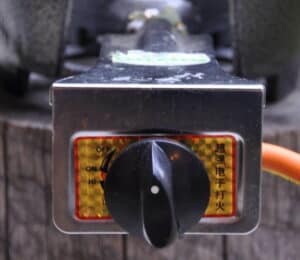
The pilot light is switched on via automatic or manual ignition. After the flame burns, the main valve should be opened. The flame may be at full capacity. The regulator, close to the gas tank, must be turned back to lower the flame, at least half way. This should produce an inch and a quarter of blue flame.
By backing off the pressure on the regulator, the blue flame will come down to about three-quarters of an inch.
The flame is controlled by the main valve on the burner. This will either increase or decrease the size of the flame, depending on how you adjust it.
The washer on the valve stem opens to allow more air into the air/fuel mixture. This also softens the flame. By closing this valve on the valve stem, you will increase the flame’s intensity. The flame will become more red and more intense. The British Thermal Unit (BTU) is produced by the natural or propane gas used to power the wok. When the air/fuel mixture is set higher, then the flame will be more intense and vice versa.
It is essential to set up your wok burner the right way to ensure safe usage. I cover this in my other post “how to use and set up wok burner”
How many BTU-s do you need for a wok
To make proper stir fry, you need a 100000 BTU wok burner. The best wok to use with this kind of BTU power is carbon still wok. With 100000 BTU you can reach caramelization temperatures (330 F – 166 C) in seconds. Maintaining this temperature is the key, and you can only hold this temperature with enough BTU power.
Do keep in mind that the actual wok burner does not determine the BTUs power, the high-pressure regulator does.
Also, you don’t always use the maximum BTU capacity when you stir fry. You adapt the power depending on what ingredient you are stir-frying. For example, if you use full power when you add eggs to the oil, they will burn very fast, but if you add a lot of vegetables at once in a wok, you will need the maximum power, so the vegetables don’t release water.
You could use wok burners with less BTU, but you would need to adapt the ingredient quantity so the temperature doesn’t drop and ingredients don’t start cooking instead of frying.
When it comes to heating up the wok, in order to cook a stir-fry, you need adequate heat. If the wok burner does not produce a sufficient amount of heat, the ingredients will not heat to the correct temperature.
Stir-frying is a sub-category of frying known as shallow frying. It requires a substantial amount of heat. The temperature needed to properly prepare a stir-fry is critical.
When food cooks at between 280°F and 330°F (140 to 165°C) it causes the chemicals on the surface of the food to interact with each other. This creates the molecules responsible for the flavor in the food after it has been cooked. This chemical reaction is known as the Mailard Reaction.
When preparing food, it is imperative to keep food at the correct heat in order to ensure that this reaction takes place. The amount of food in the wok will also determine the amount of heat required in order to achieve the Mailard Reaction.
When cooking in a wok there are a few simple things to keep in mind. The first thing is that you want the heat in the wok to initially be high enough so that when the food hits the wok the temperature will be maintained and the Mailard Reaction can be activated. This heat will also depend on how much food will be prepared in the wok at any given time. The temperature of the raw food will bring down the temperature in the wok initially.
You want to be sure that the temperature will hold up and be maintained. For this you will need a powerful wok burner that is able to produce the exact amount of heat required to properly cook the food.
Once the food has started cooking, the heat can be turned off to a lower setting. The food should continuously be stirred to ensure that it does not burn to the bottom of the wok and that the heat is evenly distributed.
One of the main reasons that you need a wok to heat up to a sufficient heat is that you want to achieve wok hei, create an intense smoky flavor, and seared-and-crunchy vegetables.
How hot is a wok burner
Wok burners for home use can output a maximum of 47000 BTU to 120000 BTU (14 to 35 kilowatts = 49 to 126 megajoules). But the most and the best wok burners can output 100000 BTU.
| How many BTU is a wok burner | ||||
|---|---|---|---|---|
| Name | Picture | BTU (British Thermal Unit Value) | MJ (Megajoules) | KW (Kilowatts) |
| Wok burner 25 kw | 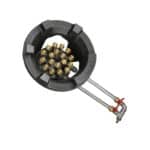 | 85000 | 90 | 25 |
| Wok burner 5B |  | 100000 | 105 | 30 |
| Commercial wok burner | 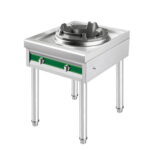 | 116000 | 122 | 35 |
Is 15000 btu enough to stir fry
Many people ask me, Is 15000 BTU enough for stir-frying.
The short answer is, it is enough, but you must adapt some things to get adequate results:
Preheat the oil
It is essential to preheat the oil to the smoking point. Use peanut oil or canola oil. With hot oil, the temperature doesn’t drop when you add the first ingredients. Stir frying starts immediately. If you add ingredients to cold oil, ingredients start releasing juices, and you end up with sauteing ingredients instead of stir-frying.
Adjust the amount of ingredients
If you only have 15000 BTU available, you should stir fry for only 1 to 2 people at once. Cooking for more requires more ingredients, and the temperature will drop significantly when you add the ingredients to the wok.
Keep ingredients dry
Another thing to consider is to keep your ingredients dry. This means you shouldn’t use ingredients right after you wash them. Pat dry ingredients with a paper towel or prepare them in advance so the water dries. If you put wet ingredients into a wok and do not have enough heat, the water will lower the temp of the wok.
Prevent the release of juices from the meat
You can easily achieve this by applying a thin layer of corn starch onto the meat. Cornstarch works as a shield for the juices.
Keep ingredients at room temperatures
Let’s say you are making thai fried rice. If you don’t have much time on hand, you probably precook your rice one day in advance. You store the cooked rice in the fridge overnight. Once you start stir-frying, never put the rice straight from the refrigerator into the wok as the temperature will drop. The best thing to do is to take the rice out of the fridge and leve it at room temperatures for at least 2-3 hours before you start to stir frying. With room temperature rice, you get better results than using rice straight from the fridge.
The same goes for all ingredients.
Avoid adding frozen ingredients
It is best not to put frozen ingredients directly into the wok if you only have 15000 BTU. Frozen ingredients don’t present a problem if you use a proper high 100000 BTU wok burner.
Cook in sessions
You could also cook in sessions, so the wok doesn’t get overcrowded with ingredients. Too many ingredients in the wok will lower the temp. The solution is cooking in sessions. First, stir fry the meat and then the vegetables. When both are done, combine them in a wok.
How can you get 100000 BTU out of wok burner
The actual wok burner does not determine the BTUs power or heat. The PSI (BAR) regulator determines the BTUs output.
You can get and use the following regulators on wok burners:
| High pressure regulators for wok burners | |||
|---|---|---|---|
| Name | picture | PSI | BAR |
| Regulator 0-20 PSI |  | 0-20 PSI | 0-1.3 BAR |
| Regulator 0-30 PSI |  | 0-30 PSI | 0-2 BAR |
| Regulator 0-60 PSI |  | 0-60 PSI | 0-4 BAR |
